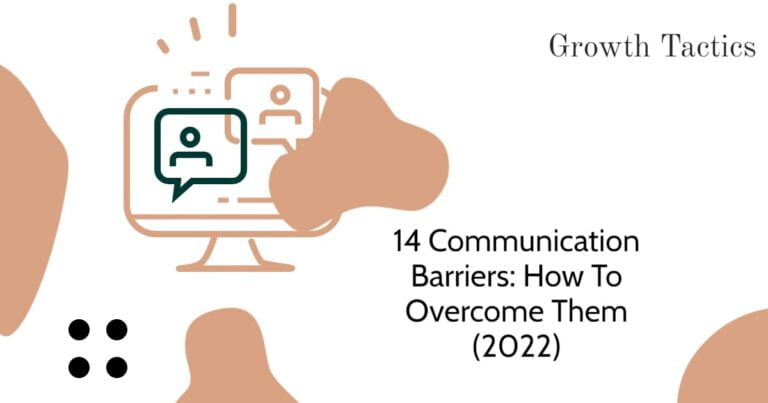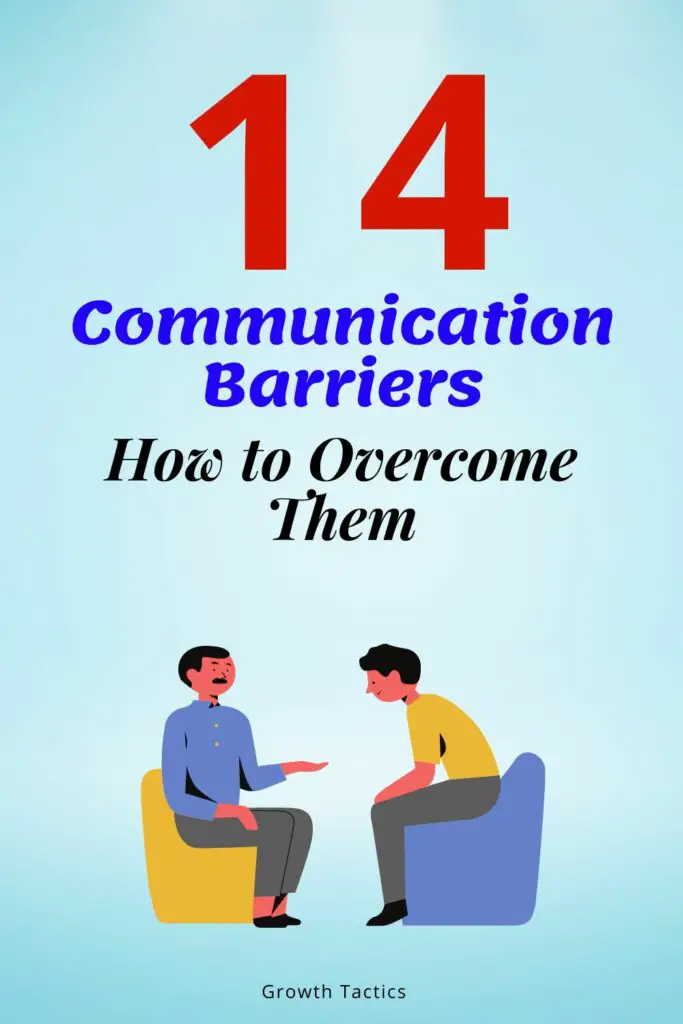Communication is a vital skill to have in your arsenal. It’s how you make friends, build relationships, and solve problems. But, sometimes it can be difficult to communicate with other people because of the communication barriers we face in our everyday lives.
The ability to overcome these obstacles is important if you want your communication methods to be effective and efficient.
You may find yourself facing some of these challenges at some point during your life. In this article, we’ll discuss how to overcome 15 common communication barriers.
Jump To Section
What Are Communication Barriers?
Communication barriers can be internal or external, physical, emotional, cultural, or situational. These barriers are the reasons why it’s difficult for people to communicate with each other. Because of these obstacles in communication, misunderstandings often occur between people from different cultures or backgrounds.
Most communication barriers can be overcome with effort and practice.

What Are the Consequences of Communication Barriers?
Communication barriers are more than just frustrating. They can lead to a breakdown in relationships, misunderstandings, and conflicts. This can cause stress and make you feel like you’re not being heard. It can even lead to health problems.
When you don’t communicate effectively with others, it often takes the form of avoiding them or keeping yourself distant from them. But this only makes things worse because when we keep ourselves closed off from others, they won’t know how they might be able to help us or what we need from them.
What Are the Different Forms of Communication
There are many types of communication, but most of them fit into one of the 4 categories below:
- Verbal Communication: This form of communication involves the use of words to express ideas and concepts. It is spoken communication.
- Non-Verbal Communication: This form of communication does not involve spoken or written language. Examples include gestures, facial expressions, and body movements. Often this type of communication can say more than verbal communication.
- Written Communication: This form of communication involves the use of letters or words printed on paper to convey information through print media such as newspapers, magazines, or books.
- Electronic Communication: This is another way that we can communicate with one another. Through the use of computers, smartphones, and other technology devices that transmit data electronically across long distances at high speeds. This includes text messages and emails.
See Related: How to Master Communication Skills! 15 Powerful Tips to Improve Starting Today
What Are Some Types of Communication Barriers?
There are many reasons why communication barriers occur. Some of the more common reasons are:

Generational Barriers
Many barriers can prevent effective communication between people. Some of the most common include generational barriers, resulting from the different ways each generation communicates.
For example, millennials typically prefer texting over talking on the phone and have developed their own unique language such as “LOL” or “totes.” They also communicate efficiently, replying with short but precise messages such as “yes” or “no.”
In contrast, older generations may take longer to respond or send more detailed emails that require multiple responses before moving on to another topic.
Those in Generation X love using emoticons and excessive capitalization (e.g., “EXCITING NEWS!”), while baby boomers prefer handwritten notes over emails altogether because they feel like this form of correspondence better captures the tone of their message than typed words alone.
Overcoming Generational Barriers to Communication
This is a very common barrier we encounter in the military, where different generations coexist and must effectively communicate for successful operations. The key to overcoming generational barriers is to take the time to understand each other and create an open and honest dialogue about communication expectations within the military hierarchy.
Failure by One or Both Sides to Listen
When one or both sides of a conversation are not listening, it can lead to a lot of problems.
The first issue is that messages may get misinterpreted or not heard at all. It’s easy for people to hear what they want to hear when they’re not really paying attention. Especially when the other person is talking about something that doesn’t interest them as much as their own thoughts on the subject matter.
When this happens, trust between two people may suffer and conflict could result from miscommunication. Have you ever said something with good intentions only for it to be taken out of context? Then used against you by someone else in an argument. Then you know how frustrating failing to listen can be!
Overcoming the Failure to Listen Communication Barrier
To overcome this barrier, it is essential to emphasize the importance of active listening skills. Encouraging individuals to practice attentive listening, paraphrasing to confirm understanding, and maintaining an open mind can promote clearer and more meaningful communication.
By fostering a culture of active listening, both sides can engage in more productive and empathetic conversations, enhancing collaboration and building stronger relationships.
Physical Barriers
Physical barriers to communication can pose significant challenges in effectively conveying information and understanding. These barriers refer to external factors and environments that physically hinder the smooth flow of communication.
For instance, distance can be a physical barrier that limits face-to-face communication, making it difficult to observe body language or hear subtle nuances in speech. Additionally, noisy environments or distractions can create obstacles, as they can drown out important dialogue and impede attentive listening.
Overcoming the Physical Communication Barrier
To overcome this barrier, it is crucial to utilize appropriate technology and adapt communication methods. Implementing video conferencing or teleconferencing solutions can enhance visual and auditory communication, bridging the physical gap. Clear and concise written communication, such as emails or messages, can also help convey information accurately.
Additionally, providing accessibility aids and using visual aids or gestures when necessary can improve understanding for individuals with hearing or visual impairments. By actively seeking solutions to overcome physical communication barriers, we can ensure that all individuals are included in the conversation and enhance overall communication effectiveness.
Lack of Interest
Lack of interest can be caused by a lack of motivation, or it could be caused by an inability to understand what the other person is saying. When two people have different interests and priorities, they will have less in common and therefore find it harder to communicate effectively with one another. This can lead to misunderstandings and conflict if not addressed properly.
Overcoming a Barrier Caused by Lack of Interest
Here are some things you should try when trying to overcome a lack of interest.
Find out why they don’t care as much as you do about what you’re talking about. For example, maybe they don’t like public speaking or they’re just generally shy people who find it difficult to become enthusiastic about anything new that comes along their way.
Whatever the reason may be for their indifference towards your topic of interest. That’s something worth knowing so that both parties involved can make informed decisions on how best to move forward together (or apart).
See Related: 13 Body Language Examples: Non-Verbal Communication Skills

Not Understanding the Emotions of the Other Person
Emotional intelligence is the ability to understand and manage your own emotions and to recognize and understand the emotions of others. In short, it’s understanding how someone is feeling.
It’s not just about being able to read someone’s face or body language. It’s also about decoding their tone of voice, what they say, and what they don’t say, as well as their actions.
It’s also important to understand how you feel in response to what they do or say. This means understanding your own emotions.
When you first start communicating with another person, it can be difficult or even impossible for you to read their emotions. But if you’re very observant, you will start to see some clues and pick up on how they’re feeling.
Prejudices
Prejudice is a form of discrimination based on negative attitudes towards specific groups of people. Prejudices can be based on race, religion, gender, age, sexual orientation, and so on.
Prejudices can make it hard to communicate with people from other cultures or backgrounds. It’s important to understand that people who have prejudiced attitudes aren’t necessarily bad. They may just need more information about the group they don’t understand.
Overcoming Communication Barriers Caused by Prejudices
To overcome this barrier, it is essential to foster a culture of inclusion, respect, and empathy. Leaders and individuals must address their own biases and prejudices, actively seeking to understand and challenge them. Creating opportunities for open and honest dialogue can help break down stereotypes and promote understanding.
Emphasizing active listening, empathy, and perspective-taking can also help individuals overcome their own biases and better understand others’ experiences. By actively working to overcome communication barriers caused by prejudices, we can foster a more inclusive and harmonious environment, where genuine and meaningful communication can thrive.
Language Barrier
Language barriers can arise in international communication due to different native languages. This is common when you are communicating with people from a different country or culture, but it can also happen within one country.
Language barriers arise when someone does not understand what you are saying because their native language differs from yours. If you have ever tried learning another language, then you know that even if your grammar and pronunciation are perfect, there will still be instances where someone will not understand what you mean because they do not use the same words as you do.
A good example would be two people speaking German who want to say “I want ice cream”. One person says “Ich möchte Eis” while another says “Ich will Vanille-Eis” meaning that although both sentences sound similar in English (they both mean “I want vanilla”), they are actually completely different!
Overcoming Language Barriers
There are several ways in which we can avoid having these types of problems when communicating internationally.
Be aware of cultural differences and avoid making assumptions based on how things were done back home (e.g., don’t assume everyone eats meat like Americans). Write out messages ahead of time so they’re more likely to make sense regardless of who receives them (e.g., send emails rather than handwritten letters). Use technology like Google Translate’s smartphone app which translates spoken phrases into written ones instantly without requiring an internet connection. This makes it easier for everyone involved!
Different Communication Styles
Different individuals have varying communication styles, which can lead to breakdowns in conversations if not addressed. These styles can include differences in speaking pace, body language, and tone of voice. Understanding and adapting to these styles is crucial for effective communication.
- Talkative Style: Some individuals tend to talk more than others. They may have a fast-paced speaking style and might dominate conversations. When interacting with someone with this style, it is important to actively listen, ask clarifying questions, and provide them with ample time to express their thoughts before interjecting. Being patient and allowing them to finish their train of thought can lead to a more productive conversation.
- Slower-paced Style: On the other hand, some individuals have a slower-paced speaking style. They may take their time to gather their thoughts before responding. When conversing with someone who has this style, it is crucial to avoid interrupting and allow them sufficient space to express themselves fully. By actively listening and giving them the time they need, you can foster a more comfortable and inclusive communication environment.
- Expressive Style: Some individuals may express themselves more through body language and tone of voice. They may use gestures, facial expressions, and varying vocal tones to convey their message. When engaging with someone with an expressive style, it is essential to focus on both their verbal and non-verbal cues. Being attentive and interpreting their non-verbal signals can help you better understand their intended message and avoid misinterpretations.
Overcoming Different Communication Styles
To overcome communication barriers caused by different communication styles, consider the following strategies:
- Active Listening: Engage in active listening by giving your full attention to the speaker and understanding their style. By attentively listening to their words, tone, and non-verbal cues, you can grasp the underlying message and respond appropriately.
- Adaptation: Be flexible and adapt your communication style to match that of the person you are conversing with. When interacting with someone with a slower-paced style, slow down your own pace to create a more comfortable interaction. Conversely, when speaking with someone who is talkative, be concise and allow them to express themselves fully.
- Clarification: If there is a misunderstanding or miscommunication due to different styles, seek clarification. Ask open-ended questions to ensure you have correctly understood the speaker’s intended message. Clarifying any unclear points can help bridge communication gaps.
- Respect and Empathy: Show respect and empathy towards others’ communication styles. Avoid judgments or assumptions, and instead, seek to understand their unique way of expressing themselves. By practicing empathy, you can build stronger connections and foster a more inclusive and constructive communication environment.
By acknowledging and adapting to different communication styles, we can effectively communicate with individuals who have varying ways of expressing themselves, leading to more successful and meaningful conversations.
Previous Conflicts
Previous conflicts can be a barrier to conversations. They can lead people to be either stand-offish or timid. One side or the other may be either still upset about the previous conflict or fearful of starting another conflict.
When previous conflicts arise during communication, they often affect conversations negatively because people are worried about repeating their mistakes or upsetting each other again.
Overcoming Barriers to Communication Caused by Past Conflicts
The best way to deal with these situations is by addressing them directly and openly while focusing on solutions rather than problems. E.g., “I know we’ve had some issues in the past but I want us both to be able to work together better going forward”.
See Related: How to Resolve Conflict in the Workplace: 12 Effective Strategies
Cultural Differences
Cultural differences are a common barrier to effective communication. People from different cultures have different ways of thinking, feeling, and behaving. Which can lead to misunderstandings between people who speak the same language.
For example, in some cultures, it is considered polite to finish every sentence with “please” or “thank you”. In other cultures, this might be seen as unnecessary or even rude.
Another way that cultural differences can cause communication problems is when one person uses an informal style of speech while another uses a formal style of speech. For example:
“You haven’t done the dishes yet?” (formal) versus “Dude, you did not wash those dishes.” (informal)
Overcoming Cultural Communication Barrier
To overcome this barrier, it is crucial to develop cultural competence and enhance cross-cultural communication skills. This includes educating oneself about different cultures, their values, customs, and communication norms. Showing respect for cultural diversity and embracing a mindset of curiosity and open-mindedness can foster better understanding and empathy.
Actively seeking to bridge the cultural gap by asking questions, clarifying assumptions, and avoiding stereotypes can create a more inclusive communication environment. By incorporating cultural sensitivity and adapting communication approaches, we can effectively navigate cultural differences and promote successful communication across diverse backgrounds.
Educational Barriers to Communication
In addition to the many different types of communication barriers, there are also educational barriers.
Because we have different education levels and backgrounds, people can sometimes struggle with communication because they don’t know certain words or phrases. Depending on your education you may use a more academic language than someone who didn’t go to college and is less well-read.
If you’re like me and went through high school without learning all of the fancy words that make an essay sound intelligent you might feel intimidated by these terms when they pop up in conversation with others. But don’t worry! There are ways around feeling limited by what you know and how much education you’ve had.
Dealing With Educational Barriers to Communication
First off, if something doesn’t make sense right away but has an important meaning for understanding what someone else is saying (like zeitgeist), ask for clarification about what a person means before judging their intelligence based on their choice of words alone!
Also, remember that sometimes smart people do dumb things like using big words incorrectly when simpler ones would work better. Try not to get hung up on vocabulary alone when assessing whether someone understands what they’re talking about.
Locational Barriers
In addition to educational barriers, there are also physical and geographic barriers.
These can be a barrier to effective communication because they limit the amount of time you have with your friends or family members. If you live far away from your co-workers, for example, you may only be able to see them at odd times. In this situation, it would be difficult for either party to ask questions about their job or recent events because of the time differences.
Overcoming Locational Communication Barrier
To overcome this communication challenge, the use of technology plays a crucial role. Leveraging tools such as video conferencing, instant messaging, and collaboration platforms can facilitate real-time communication and foster a sense of connection, regardless of distance. Setting clear expectations and establishing regular communication channels can help overcome the potential lack of face-to-face interaction.
Additionally, it’s important to be mindful of time zone differences and accommodate schedules to ensure inclusiveness. By utilizing technology effectively and implementing communication strategies tailored to remote collaboration, locational barriers can be effectively mitigated, allowing for seamless communication across distances.
Status Conflicts
Status conflicts occur when people have different levels of authority. For example, you may be interacting with someone who is the boss of your company and that person has the power to fire you. They could also be an employee at a higher level than you.
When this happens in professional settings, such as schools or workplaces, status can cause tension because it’s difficult for people with high statuses to understand their place in their relationship with those who have less authority or power than them (like employees). In these cases, it may feel like there are barriers between people because they don’t know how to communicate appropriately when faced with an authority figure or superior.
It’s important to remember that these types of relationships aren’t fixed. They change over time depending on how things go between two people and their respective statuses change as well!
Overcoming Status Conflicts Communication Barrier
To overcome this barrier, it is important to foster a culture of open dialogue and mutual respect. Encouraging equal participation and active listening can create an inclusive environment where everyone’s ideas and perspectives are valued.
Leaders and individuals should be aware of their own biases and ensure that everyone is given an opportunity to contribute without fear of judgment or repercussions. Building trust and creating a safe space for open communication can help overcome status conflicts and promote collaborative and effective communication among team members.
Political Differences
It’s an unfortunate fact that political beliefs can be a source of conflict. Even in the most loving relationships. If you and your partner are on opposite sides of the political spectrum, it may cause communication problems in your relationship.
Dealing with Political Barriers to Communication
To avoid these issues, consider taking this approach. Instead of trying to change each other’s minds or arguing about politics all the time, focus on what matters most in life: one another!
Sharing Too Much
Sharing too much is a common communication problem. We all want to communicate as much information as possible, but in reality, it’s important to know what we should share and what we shouldn’t share.
When you’re communicating with someone, the first step is listening. You have to listen to them to understand your message. If you don’t listen well enough, then the person on the receiving end may not understand what you’ve said, or even worse, they may get offended by something you’ve said.
Avoiding this Communication Barrier
The best way to avoid sharing too much information is by only giving the necessary information. Also, pay attention to the other person’s body language. For example, if a person starts to look bored it may be a sign that you are sharing too much information.
How Can We Overcome Communication Barriers?
Although there are many communication barriers there are also many ways to avoid or overcome those barriers. We’ll discuss some of the best ways to overcome barriers to effective communication below.
Talk Clearly
You can’t expect someone to understand you if you speak in a mumbling voice, or so fast that the other person has no chance of understanding.
To avoid this, be sure to enunciate clearly when communicating with others. It’s best to speak in a loud and clear voice, using short sentences and words that are easy to understand. This will help ensure that others can follow along as well!
Use Simple Language
Another thing you can do to help people understand you is to use simple language. Simple language means using short sentences, simple words, grammar, and punctuation rules that are easy to follow. Overcoming barriers also means using simple sentence structure and word order.
Here are some good examples:
- “I need a pen.” (Simple)
- “I need a pen to write with because I don’t have one.” (Complex)
As you can see both of these sentences mean the same thing. But the first one is way simpler than the second one.
Personalize Conversations
In a professional setting, it’s important to be polite and respectful of others. However, you can go above and beyond by making sure that each person feels valued by you as an individual.
One way of doing this is by paying attention to the other person’s name when addressing them. For example: “Hello, John.” Or “Hi there, Mary.” This can help them feel more comfortable with you because they know that what they have to say matters.
Another good thing is asking questions about themselves. What their interests are or where they grew up are great examples. This will help you get to know them better before starting on any business-related topics.
Use Technology to Your Advantage for Effective Communication
Technology is used in a variety of ways to overcome communication barriers.
Some examples include email, text messaging, and online chat services such as Skype and Google Hangouts. These methods are often used instead of face-to-face meetings or phone calls because they allow businesses to save time and money. While still getting their points across clearly without having an awkward conversation about how many times you should meet up before making any kind of commitment.
The use of technology doesn’t just benefit individuals. It can also help companies increase productivity by making communications more efficient and effective with fewer interruptions. This allows teams within a company (or even across different departments) have more productive conversations while still being able to reach out if needed via instant message or video call.
In fact, some companies even encourage employees to use new communication techniques like Slack rather than emails if possible so that everyone stays focused on what they need to do. Instead of clicking through multiple messages.
Make Conversations 2-Way
One of the most common barriers to communication is the fact that people often talk at each other, not to each other. This can be frustrating for both parties as it leads to misunderstandings and miscommunication.
So how do we avoid this? By making sure every conversation is a two-way street. Here are some tips to make sure that happens:
- Listen! – Make sure you are listening to what the other person is saying and not thinking about your next line or just waiting for them to finish so you can jump in with what’s on your mind. When speaking with someone, pause after they speak and give them space before responding so they know you heard them.
- Don’t interrupt – Interrupting someone shows that you don’t respect their time or interest in sharing their thoughts with you. It also makes it more difficult for them to articulate themselves because they are constantly having their train of thought derailed by yours!
- Don’t talk over – When speaking with someone else, make sure that if there’s an interruption (like somebody else coming into the room), wait until they stop talking before interjecting yourself into the conversation again. Take note of whether or not their voice tone has changed since last speaking together too. If so then chances are something important was just said that needs addressing first before continuing normally!
Look For Conversational Feedback
If you’re trying to communicate with someone and they have a language barrier, look for conversational feedback. This is the best way to tell if they understand what you’re saying and if they don’t get it, you can adjust your language accordingly.
Here’s what to look for:
- Facial expressions
- Body language (do they look bored? Do their eyes dart around?)
- The tone of voice (is it too loud or too quiet?)
- Eye contact (does he seem interested in what you’re saying?)
- Head nods
- Smiles
Find a Quiet Place to Talk
It’s often difficult to find a quiet spot in the workplace, especially if you work in an open-plan office or cubicle farm. The best way to overcome this is to find a quiet place outside of the main office. If you can take your colleague out for coffee and have some time away from distractions, even better!
Get to the Point of Your Conversation Quickly
Taking too long to get to the point can cause issues in some conversations. Especially when there are communication barriers in place. Taking too long to get to the point can cause boredom and allow the other person’s mind to wander.
Know Your Audience
The most important thing to remember when communicating with another person is that you must know your audience. You need to know their values, beliefs, and interests. If you don’t know this information then it will be difficult for you to connect with them on a personal level and get your message across.
What do they like to talk about? What makes them angry? What are they passionate about? These are all questions that can help you have an effective conversation with your target audience.
See Related: 9 Public Speaking Tips to Beat Those Nerves
Be More Open-Minded to Others’ Beliefs
You can do this by listening to the other person’s point of view and trying to understand where they are coming from. This is a form of active listening. Try to see things from their perspective instead of just hearing what they are saying, and be open to new ideas that may contradict your own beliefs. By doing this, you will be able to overcome any communication barriers between yourself and others effectively.Avoid Information OverloadIn today’s fast-paced world, we’re often bombarded with loads of information, making it challenging to stay focused and avoid feeling overwhelmed.So, how can we tackle this?First, set clear priorities and focus on what truly matters.Next, limit your sources and choose reliable ones that provide valuable insights. Stay organized by using tools like folders and bookmarks to manage information. Take regular breaks to give your brain a rest. Lastly, practice selective attention by honing in on what’s most relevant and tuning out distractions. By finding this balance, you can navigate the digital landscape confidently and prevent information overload.
Communication Is an Important Part of Everyday Life, so It’s Important to Know How to Communicate Better
Communication is not just about talking. It’s about listening and understanding the other person.
Communication involves understanding the situation and emotions of the other person. If you don’t understand what they’re feeling or their perspective on a topic, then it will be hard for them to trust you enough to listen openly and share their thoughts with you effectively.
It might also help if you ask yourself the following questions. What are my goals in this conversation? What do I want out of this interaction? How do I want my partner/friend/colleague/etc., feel after we’re finished speaking? Your goal should be clear in your mind before attempting any kind of communication with another person or group!
In conclusion, there are many types of communication barriers and ways to overcome them. Understanding what a communication barrier is and how it can affect you personally or professionally, can make all the difference in your life.
Did you enjoy this article on how to overcome communication barriers? Don’t forget to share and subscribe below.


